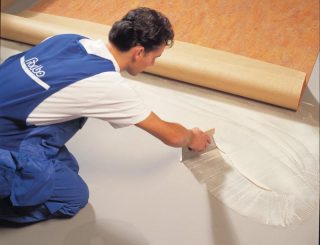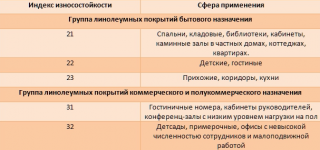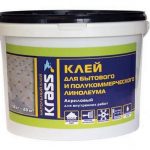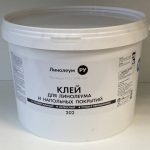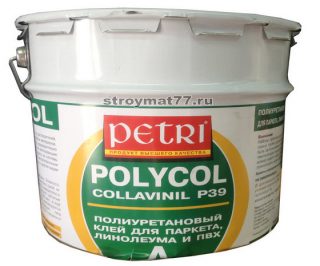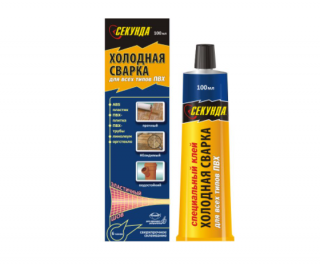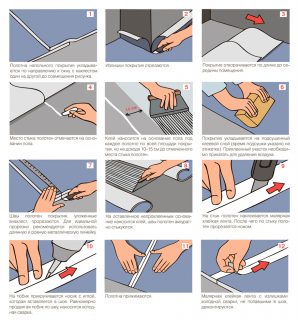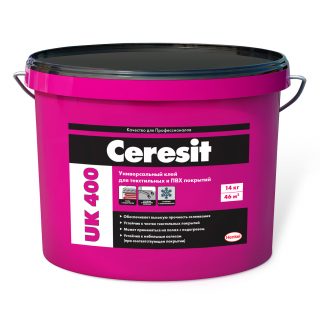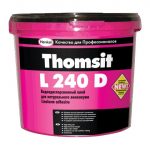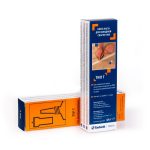Linoleum flooring involves gluing. Without meeting this requirement, the manufacturer does not give a guarantee for its products. The glue ensures the immobility of the material even under heavy load and tight joint. However, not all adhesives are suitable for the job.
Description and properties of glue for linoleum
The basis of the mixture is different: acrylic, aqueous solution, cellulose acid, rubber. When choosing, take into account the type of foundation, the nature of the floor. The operating conditions also matter. For warm apartments, they take cheaper adhesives based on latex or acrylic. For damp rooms or balconies, a polyurethane-based mixture will be needed, as it tolerates temperature changes better.
The composition sets quickly - from 10 to 60 minutes. This must be taken into account during work.
Requirements
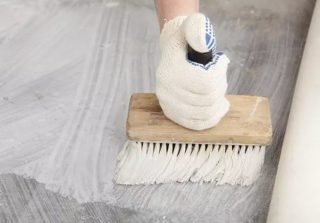
Linoleum is a rather dense material, but structured. Almost any adhesive is suitable for it. The basis is more important - concrete, wood, old soft coating.
Therefore, the requirements for glue for linoleum are not too high.
- Linoleum compatibility - the material may have a different basis: felt, fabric, foamed. Even baseless linoleum is produced. The glue must be compatible with it. This is indicated on the packaging.
- Good grip - is determined by the adhesive properties of the adhesive in relation to the base.
- Water resistance - relative. Special brands are chosen only when laying in the bathroom, pool, gym.
- Safety - adhesives are non-toxic, do not have a pungent odor.
- Resistance to temperature drop - when the linoleum swells and deforms when the furniture is rearranged, the "fault" falls not on the material, but on the glue.
- Life time - a high-quality composition can increase the life of the floor by 30-40%.
An optional but important requirement for the user is economical consumption. In different cases, 1 kg of the composition ensures the laying of 2–5 m² of linoleum.
Varieties of compositions
- for semi-commercial use - that is, designed for a moderate load;
- commercial - designed for shopping centers, cinemas, dance floors.
Linoleum is available in rolls. On the one hand, this ensures greater ease of installation: the roll can be easily cut into pieces of the desired length and glued by rolling it over the surface.On the other hand, at the same time, the canvas is quite tight to the floor, but the edge does not. For the adhesion of particularly thick and rigid materials, formulations with high adhesion properties are required.
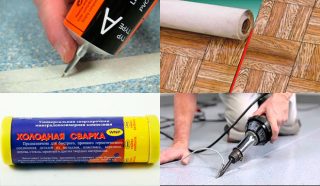
Adhesives are divided into 2 more groups:
- for the foundation - that is, for gluing the canvas itself;
- glue for linoleum joints - creating a stronger grip.
Most of the characteristics depend on the composition. Most often, dispersion or reaction compositions are used.
Dispersive
It is water-based. This adhesive is easily diluted and reduces the adhesive properties under the influence of excessive moisture. It cannot be used if the moisture content of the base exceeds the norm - the linoleum will not stick.
Dispersion mixtures are quick-drying, non-toxic. Designed for absorbent substrates - concrete screed, for example. If the floor is tiled, you need to choose a different composition.
Dispersion adhesives category includes the following mixtures.
- Acrylates - based on acrylic resin. The substance is viscous, thick, provides excellent adhesion. It is used for linoleum on a jute or synthetic base.
- Bustilat - a water-soluble mixture based on latex, chalk and cellulose thickener. Differs in high elasticity, strength, frost resistance. Used for working with felt-based material.
- Humilax - includes rubber and latex. Perfectly applied, dries quickly, has high adhesion to concrete, wood, stone. Suitable for linoleum on felt and fabric backings. It can be taken for laying natural linoleum.

Reactionary
Received its name for the mechanism of action. When gluing, an additional polymerization reaction occurs. Due to this, the adhesion strength is greatly increased. This quality is not always in demand, so more often the mixture is taken for gluing joints or processing areas with a very high load.
Freezing reaction glue "Tightly" connects the base and linoleum... It is very difficult to dismantle the flooring. But even when moving heavy furniture or equipment, linoleum is not displaced or damaged.
Distinguish 2 types of mixture.
- Polyurethane - application on any surface with any degree of absorption. The composition is non-toxic, it is allowed to use it in residential premises.
- Epoxy - two-component composition. Provides very high bond strength and durability. However, it is poisonous, and upon drying it releases toxic substances. The glue is used in industrial facilities.
To improve the adhesion of the substrate, the floor is treated with a primer.
Criterias of choice
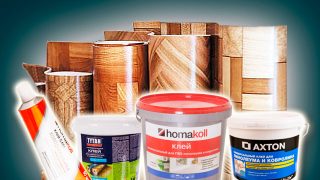
When choosing an adhesive, consider the following factors.
- The nature of the room - the dispersion composition is quite suitable for the living room or even the kitchen. It is non-toxic, dries quite quickly, and in living quarters the load on the floor is low. If we are talking about a shopping center, take a contact or reactionary.
- The nature of the foundation - if the surface absorbs moisture, but the moisture level does not exceed the norm, it is better to use dispersion. For complex floors, polymer modification is suitable.
- The nature of the substrate... To glue a porous lightweight material, you can use a cheap adhesive with low adhesion properties. For a base material, a grip-enhancing compound is needed.
- The nature of the flooring - only special mixtures are suitable for natural linoleum.
On the packaging of linoleum glue, it is indicated for which type of materials the mixture is intended.
The technology of laying linoleum on glue
- Furniture is taken out of the room, skirting boards, planks are removed.They clean wood or concrete surfaces from dirt and dust.
- The base is treated with primers, most often they are antiseptic. If the floor is very uneven, dents and chips are repaired.
- The canvas is cut. This should be done with a margin, since the linoleum should go onto the walls.
- The cut fragment is rolled in half into a roll. The remaining part is applied with a notched trowel. Then the smeared canvas is rolled out on the floor and pressed.
- Roll out a piece from a roll. They are coated with glue and glued to the surface.
- If a reaction glue is used, proceed in the same way, but the composition is applied only to certain areas. This speeds up the work.
- The canvases are overlapped. After gluing the flooring, these irregularities must be removed. For this, the excess material is cut off under a ruler, masking tape is glued to the joint and an incision is made in it along the entire length.
- Glue for linoleum joints is introduced into the incision. After 10-15 minutes, remove the masking tape.
To seal the seams, take a reaction adhesive.
Manufacturers overview
- Ceresit - for household needs, water-dispersion compositions for various purposes are produced. Feature - high security. They are recommended for use in medical and school settings.
- Homakoll - water-soluble mixtures for residential premises are distinguished by a very high resistance to moisture. Suitable for living room and bathroom.
- Thomsit - manufactures environmentally friendly products recommended for use in hospitals.
- Tarkett - offers all types of adhesives: dispersion, contact, reaction. All mixtures are distinguished by strong fixation and moisture resistance.

